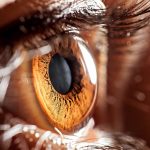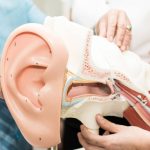Your sense of balance is the result of your brain’s integration of what you feel through your body, what your inner ear senses and what your eyes see. Post-concussion dizziness is typically the result of a sensory conflict between these inputs caused by damage to some of the brain’s neural pathways during your initial injury. When your spatial perception is impaired in this way, your physical sense of where you are is out of sync with what you see.
In this post, we’ll take about the vestibulo-ocular reflex and the two main types of concussion dizziness. We’ll discuss the various causes of concussion dizziness, then finish up by briefly outlining our recommended course of treatment at Northoak Chiropractic.
Feel free to leave a comment below if you’d like more information.
The Vestibulo-Ocular Reflex (VOR)
If you are trying to help your dizziness from your post-concussion syndrome, the first thing you need to understand is the Vestibulo-Ocular Reflex. How does it work?
Let’s take a simple example: when you are concentrating on an object in front of you (e.g. a tennis ball in your hand) and you turn your head in one direction (to the right), then your eyes will move in the opposite direction (to the left) to keep your vision steady.
This process is something that will occur automatically for most people, without them having to think or do it consciously. However, when someone has a concussion, the vestibulo-ocular reflex (VOR) may become aberrant: it will stop acting properly.
2 Types of Concussion Dizziness
When it comes to concussion dizziness, there are two basic types of people:
- People who feel dizzier when sitting still.
- People who feel dizzier when moving around.
Dizziness When Sitting
People who feel dizzy when sitting still typically have issues with spontaneous eye movements. These can be slow drifts of the eyes followed by refixations or uninhibited saccades. Spontaneous saccades are eye movements triggered by visual or auditory stimuli in the person’s surroundings. They can be due to injuries to inhibitory pathways in the brainstem.
Normally, you would be able to inhibit these random movements, but people suffering from post-concussion syndrome may have injuries causing imbalances in the output of their vestibular systems or be unable to control their reflexes. As a result, they may become hypersensitive to external stimuli, causing irregular eye movements and the feelings of dizziness as their eyes work overtime.
These people may feel better if they get into a moving car, as the movement could reduce the sensory conflict that they are experiencing. However, this can also make their symptoms worse, depending on the cause. Brain injury is a very complicated phenomenon and the best course of action is to see a trained functional neurologist to receive a full assessment.
Dizziness When Moving
People who feel dizzy when moving around may have issues with their vestibulo-ocular reflex (VOR). One example is oscillopsia, an incapacitating condition associated with a number of different neurological disorders.
People with oscillopsia will see their surroundings “jumping and moving” when they are walking. This is because our head naturally nods when we walk, due to the force transmitted as our feet hit the ground. A healthy VOR will naturally move our eyes to precisely compensate for the head movements to keep our vision steady when walking, but brains damaged by a concussion may need to be re-trained to do this.
Usually, a problem with the VOR is hypometric, which means that the eyes move, but they don’t go far enough to stay on target. In these cases, it is possible to train up this reflex using slower movements to keep a person’s gaze on target at first, then gradually increase the speed.
Treatment for Concussion Dizziness
There are many different interrelations that can occur within the brain, and you have to consider all of them when treating post-concussion dizziness. What is common to all post-concussion syndrome cases is our goal at Northoak Chiropractic: driving neuroplasticity for the patient, to improve the efficiency of their damaged neural pathways.
Treating the affected areas of the brain is always a process of test, trial, and retest. Our patients start out doing brain exercises under the supervision of Dr. Jay. Then, as we bring in more areas to create stable plasticity, the various treatments will build on each other and patients can start working on the same exercises at home.
These problems may be possible to resolve if you take the time to understand what’s causing them.
At Northoak Chiropractic, we treat a wide range of balance and dizziness disorders. If you have another dizziness condition, such as BPPV or post-cruise vertigo, we may also be able to help with this condition.
To learn more about treating your dizziness, contact Dr. Jay Burness and the team at Northoak Chiropractic or call us at (905) 338-5951.


